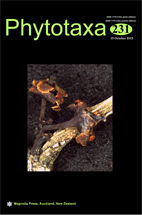Abstract
Fragilaria candidagilae Almeida, C. Delgado, Novais & S. Blanco is a new araphid diatom species, described from samples collected in central and southern Portugal (SW Europe). Fragilaria candidagilae has linear-lanceolate valves with strongly capitate apices, without spines, and alternate punctate striae. This taxon presents siliceous plaques on the valve mantle edge, two apical pore fields in the poles and siliceous depositions on the outer areolar openings in the form of rounded floating disks. The morphology of the new diatom species is documented by light and scanning electron micrographs and discussed in detail, including a morphological comparison with the type material of similar taxa such as Fragilaria recapitellata, F. capucina, F. intermedia, F. neointermedia and F. perminuta to confirm it as a new species. Statistical comparison of morphometric characters and valve shape analysis were based on at least 20 valves. Ecological notes were also included. Considering morphology and morphometry, together F. candidagilae is clearly different from other species.

